Self-leveling floor: laying technology and coating characteristics. Features of installing self-leveling floors yourself
The growing popularity of self-leveling flooring is due to many positive points related to its use. The polymer, which is the basis of the composition of this material, enters the smallest pores of concrete, significantly strengthening its structure. The use of this technology allows you to create a unique decorative coating, which also has an increased margin of strength and tightness.
The self-leveling polymer material is capable of leveling the subfloor even with pronounced unevenness and surface defects. In addition, this coating is well suited for various design experiments. Continuous improvement existing technologies production allows some manufacturers to produce high-quality materials that do not require applying a final protective layer to them.
Technical characteristics of self-leveling floor
The undoubted advantages of polymer flooring, which were appreciated by experts around the world, consist in the following technical characteristics:
- Self-leveling floors have a durable structure, thanks to which the surface can withstand various mechanical loads. A large margin of safety and increased impact strength contribute to a long service life, which reaches forty years even under intense load.
- High degree fire safety allows you to use this type of flooring in almost any room.
- No toxic emissions into the environment, regardless of temperature changes.
- One hundred percent sealing of the rough coating.
- An increased degree of adhesive properties, guaranteeing high adhesion to the subfloor, regardless of its structure.
- A perfectly flat surface, devoid of joints and connecting seams.
- Lack of response to various detergents and fuels and lubricants.
- Specially designed prevents the formation of various fungi and bacteria, eliminates the appearance of mold on the surface;
- Easy to clean, the ability to clean the floor covering with any of the available modern detergents;
- Adjustable color range flooring, creating various combinations of shades. Excellent compatibility with additional elements decoration: flocks, chips, glitter.
All these qualities contribute to the wide distribution of mixtures both in all kinds of industrial and commercial facilities, and for residential apartments.
Colored self-leveling floor
It should be noted that polymer flooring is quite easy to install, without the use of expensive tools. However important point is to strictly follow all instructions provided by the material manufacturers. Only careful adherence to the established technology guarantees a long service life of the floor surface. For self-filling the polymer floor must be adhered to fairly simple plan work that even a person ignorant of construction can handle.
Installation technology
Tools required for quality installation:
- From 2 to 6 buckets intended for mixing the composition.
- A drill operating at low speeds (about three hundred rpm), equipped with a stirrer, the length of which should be greater than the depth of the mixing vessels.
- A squeegee with an adjustable gap (allows you to smoothly and evenly distribute the composition on the surface).
- A special spatula that allows you to carefully distribute the material in places with limited access (the space under heating systems, all kinds of corners of the room).
- A needle-shaped aeration roller that allows you to remove air bubbles that form on the surface of the layer (1 piece per 50m2).
- Paint shoes (shoes with spikes on the soles), allowing, if necessary, to move on a fresh floor.
- Solvent for cleaning instruments.
Carrying out work
Before performing the main work, you should carefully prepare the rough coating, carefully examining the surface for cracks, joints, and expansion joints. If defects are detected, the uneven areas are cleaned using an industrial vacuum cleaner to remove various debris and accumulated dust. After cleaning, the seams must be treated with a primer and smoothed with sealants. Various cracks must be primed special composition on a polymer base, carefully glue it with fiberglass, and then sprinkle it with quartz sand. After twenty-four hours, excess sand should be removed.
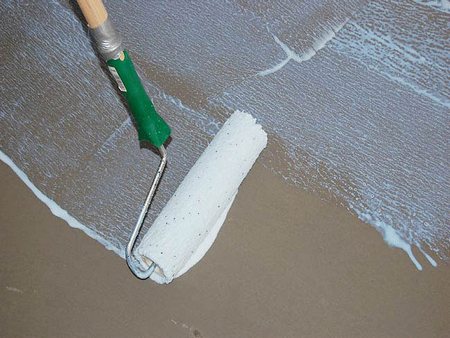 When the surface of the subfloor is leveled, you can proceed directly to the primer concrete covering. The work is performed with a special roller or spatula. To improve adhesion, a quartz sand mixture is added to the soil composition, making the surface of the starting floor rough. Among other things, a layer of primer can even out small surface differences.
When the surface of the subfloor is leveled, you can proceed directly to the primer concrete covering. The work is performed with a special roller or spatula. To improve adhesion, a quartz sand mixture is added to the soil composition, making the surface of the starting floor rough. Among other things, a layer of primer can even out small surface differences.
After impregnation of the base, you can begin installing the base layer, but it is advisable to do this no earlier than a day after the priming work.
Quartz sand is used in cases of increasing the thickness of the main working layer (relevant in places where there is expected increased load on the floor surface).
Sand can be either sprayed onto the newly laid layer or mixed directly into the resin. Sand that has not sunk into the resin is sanded and removed from the flooring. Work on applying the base layer is carried out using a special spatula with metal teeth.
The next stage of installation is applying the finishing layer of the mixture. However, some manufacturers produce materials that do not require a protective layer, because... they themselves are already the final version of the floor.
Calculation of the amount of mixture
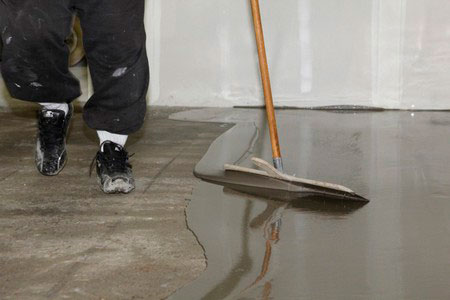 For precise definition the amount of mixture should take into account all differences in the rough coating, because in most cases there is a significant bias in one direction. In addition, the minimum permissible thickness of the mixture should be taken into account.
For precise definition the amount of mixture should take into account all differences in the rough coating, because in most cases there is a significant bias in one direction. In addition, the minimum permissible thickness of the mixture should be taken into account.
It follows from this that when installing floors, taking into account existing differences in height, the thickness of the mixture at the highest point must be no less than the minimum permissible value that the manufacturer indicated on the packaging of the material.
If the cost estimate allows you to purchase several bags in excess of the calculated norm, then it is best to do so. As practice shows, it is easier to find a use for unsold composition than to re-install a self-leveling floor damaged by a lack of composition.
Calculation of the exact amount of mixture should be done as follows:
— taking into account the minimum possible thickness of the coating, the cubic capacity of the room space that needs to be filled with a polymer floor is determined.
To do this, determine the slope of the starting surface (using a water or laser level). This is done simply:
- A horizontal level is indicated along the entire perimeter of the room.
- After this, the height difference is calculated based on the distance from the line to the floor in different corners of the room.
- Using the obtained numbers, you can calculate the relative height. To do this, you need to divide the height difference by 2.
- If we add the minimum thickness of the poured floor to the resulting value, the resulting number will be the minimum thickness of the pour.
Then you need to look at the consumption bulk mixture per 1m2 (usually the manufacturer indicates this information on the packaging), and simply substitute your values into the following formula:
(x1-x2)/2+x3=y;
where x1 is the maximum height from the floor to the level, x2 is the minimum height from the floor to the level, x3 is the minimum permissible thickness of the mixture, y is the minimum permissible total thickness of the floor.
There are cases when the height differences reach a very large difference. In such a situation, most optimal solution The floor will be poured in 2 stages. The first step is to install a thick layer. After it has completely dried, the protruding cracks and depressions are leveled using a special putty. Protrusions are eliminated. Then a finishing solvent is applied to the surface - a self-leveling solvent.
Self-leveling polymer floors are considered the pinnacle of flooring design. The properties of hardened polymers determine the popularity and distribution of such coatings in almost all organizations: restaurants, reception areas, lobbies, clubs and other public institutions.
With a skillful combination of the type of self-leveling coating and the interior of the room, you can very successfully organize such a canvas in a private house or apartment, and in any part of it - even in the bathroom.
Benefits and Features
- Completely seamless. This greatly increases its attractiveness and makes it easier to care for.
- Noble shine flat surface with a uniform color scheme or an intricate pattern - perhaps this is the main requirement for a beautiful surface
- Environmentally safe for people and animals
- Excellent wear resistance parameters allow the installation of self-leveling floors in industrial production conditions
They do not require special care and do not tend to collect dirt or accumulate dust. These features, as well as durability of use, allow self-leveling floors rapidly expand the circle of its admirers.
Types of self-leveling coatings
Polymer-based flooring comes in the following types:
1. Dry mixtures.
2. Sand-cement compositions that include polymer additives are used, rather, to level the base of the surface for the purpose of subsequent laying parquet, laminate, linoleum or boards.
Such mixtures cannot be called full-fledged self-leveling surfaces, since their use is rather just one of technological processes preparation.
3. Polymer - based on the name, for arrangement they are literally poured onto a previously prepared surface. To achieve additional decorative properties, various paints, glosses and other additions can be added to their composition. In turn, depending on the type of polymers, a distinction is made between epoxy and polyurethane.
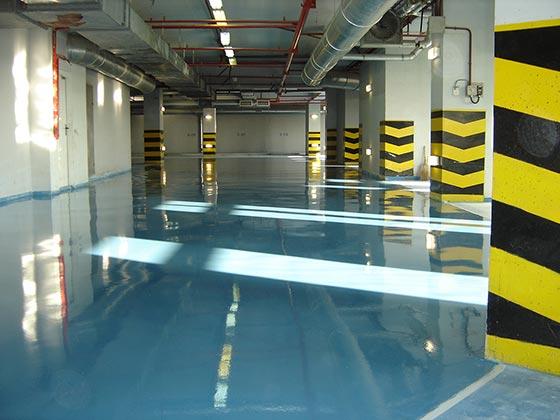 The first option has become widespread for organizing floors in warehouses and industrial premises, where decorative properties fade into the background.
The first option has become widespread for organizing floors in warehouses and industrial premises, where decorative properties fade into the background.
Polyurethane has high strength and elasticity. They received wide use when arranging houses and public institutions.
Depending on the thickness of the floor covering, thin-layer and thick-layer are distinguished.
Specifications
Accurate specifications depend on the quality and type of working building mixture. It is worth recognizing that preparing the base is one of the most important components of organizing a high-quality surface.
After applying the polymer layer, it is necessary to evenly distribute it over the floor surface and allow the required time to harden. This period also depends on the parameters of humidity and temperature in the room and can range from a day to up to two weeks.
The characteristics of exposure to aggressive environments also depend on the type of mixture. However, in general they have excellent wear resistance and resistance to mechanical damage.
 Those who want to install a poured floor in the bathroom are often afraid of the risk of destruction of the expensive floor covering from constant contact with liquid, high humidity, as well as periodic exposure to household chemicals.
Those who want to install a poured floor in the bathroom are often afraid of the risk of destruction of the expensive floor covering from constant contact with liquid, high humidity, as well as periodic exposure to household chemicals.
Unlike laminate, linoleum or parquet, which will swell and delaminate due to prolonged exposure to moisture, the self-leveling coating will serve faithfully. At the same time, polymers laid on a prepared base and kept for a sufficient amount of time will be resistant to abrasion, falling of solid objects, as well as soaking from moisture.
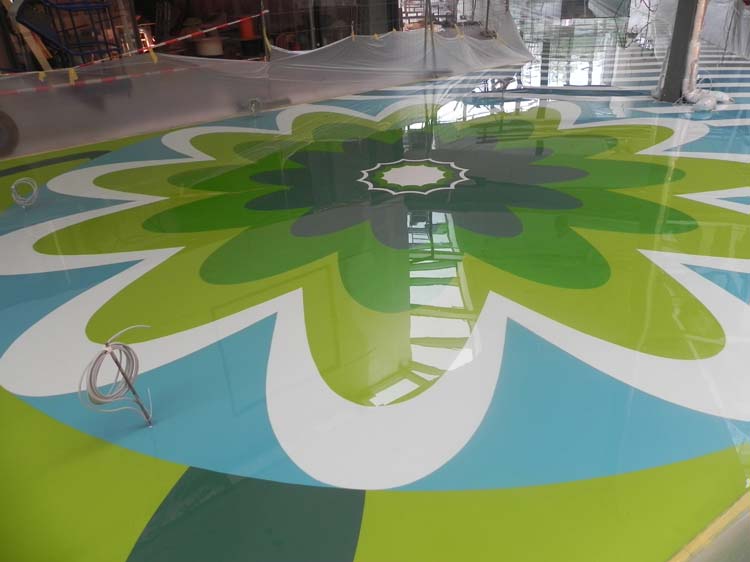 The device's capabilities are noteworthy. Unusual patterns are achieved through the use of photo wallpaper or printing images on special equipment.
The device's capabilities are noteworthy. Unusual patterns are achieved through the use of photo wallpaper or printing images on special equipment.
The desired picture or pattern will then appear under the feet of the household. It is worth noting the durability of polyurethane polymer surfaces, as well as their elasticity.
For lovers especially original design, we can recommend installing self-leveling floors in a 3D bathroom. Special installation method and application auxiliary elements will allow you to enjoy a three-dimensional pattern in the bathroom.
 The price of organizing self-leveling floors consists of two components: the cost of materials and the services of specialists who carry out the work.
The price of organizing self-leveling floors consists of two components: the cost of materials and the services of specialists who carry out the work.
Additionally, you will have to (if necessary) spend money on the services of a graphic designer, as well as on large-format printing of decorative content.
The price of a decorative self-leveling floor on a small area can range from 2,500 rubles per 1 m2 in the case of a single-color polymer coating and from 6,000 rubles per 1 m2 in the case of a 3D floor. The final cost depends on the type of mixture chosen, which determines the parameters of strength and speed of putting the facility into operation.
What to look for when choosing
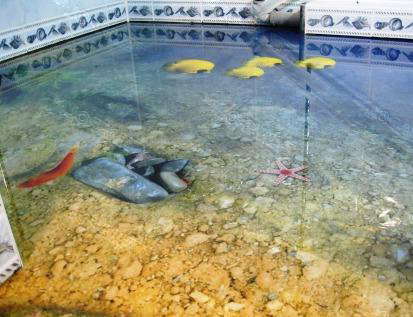 Self-leveling coatings are installed on long time. Improper preparation of the base or mistakes when choosing a color scheme will lead to additional efforts and high costs to correct the situation.
Self-leveling coatings are installed on long time. Improper preparation of the base or mistakes when choosing a color scheme will lead to additional efforts and high costs to correct the situation.
The choice of colors is solely the prerogative of the customer. However, for a bath, calm, discreet, “classic” tones are preferable. However, for fans original design There are many options for organizing decorative floors.
Surface load and foundation quality may play a role in material selection. The self-leveling floor in the bathroom is usually made from a polyurethane base. Companies that produce high-quality building mixtures for the manufacture of coatings in the bathroom are Polyushko, Florep (suitable for industrial use), TeoKhim LLC, Prospector, Osnovit, Ivsil, Litokol, Bergauf and others.
Conclusion
Self-leveling coatings, although they lie in high price segment, differ in long reliable operation, resistance to aggressive environments, as well as mechanical damage. Everyone can choose decorative design bathroom to your liking.
Today, self-leveling floors are rightfully considered the most attractive when it comes to choosing a finishing floor covering. This popularity is largely determined by the properties of this frozen polymer.
Like other materials, this one has a number of characteristics and properties that make it exceptional among many, many other materials.
Kinds
Today it is customary to distinguish only five main types of self-leveling floors, which are divided according to the material used as the basis for their manufacture:
- Epoxy;
- Polyurethane;
- Epoxy-urethane;
- Methyl methacrylate;
- Cement-acrylic.
Epoxy type flooring
Epoxy resins are used in the manufacture of this type.
Epoxy coating has the following properties:
- Hardness;
- Rigidity;
- Fragility.
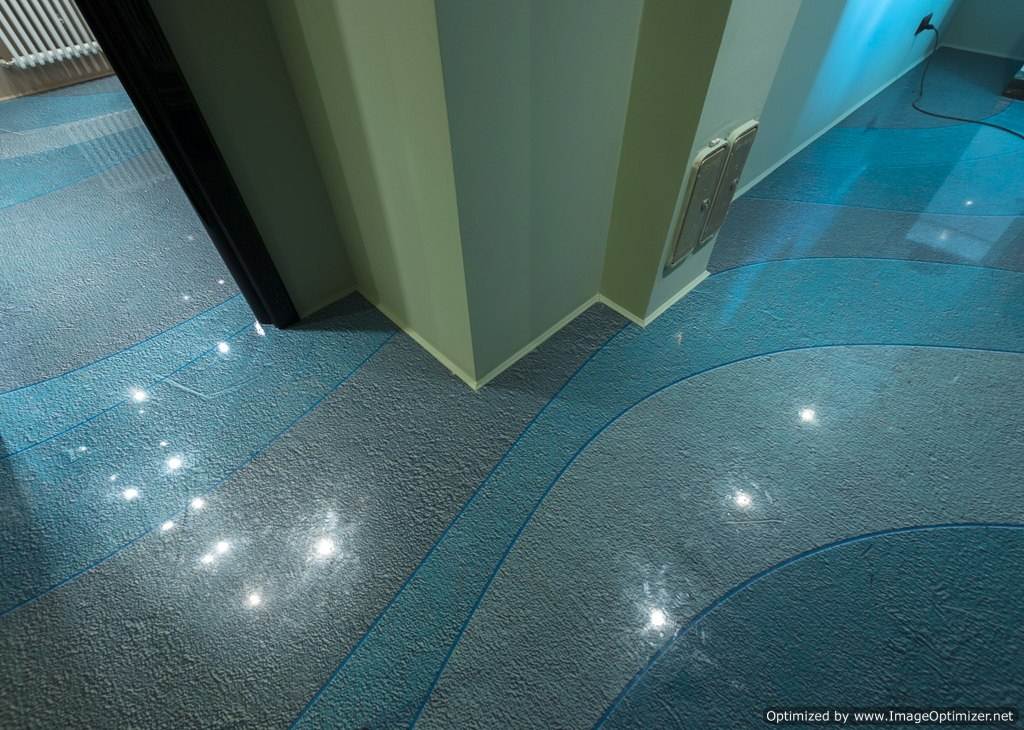
This coating has a high degree of resistance to various mechanical influences. They are not afraid of moisture and many household chemicals. Their operation is possible in the temperature range from 0 to 50 degrees above zero.
This characteristic of the self-leveling floor also determines the scope of its application:
- Chemical plants;
- Pharmaceutical premises;
- Factory premises;
- Warehouses;
- Car washes and others like that.
Polyurethane coating
This is one of the most beautiful views self-leveling floors. Besides, this type characterized by increased resistance to mechanical stress and various chemical compounds. This type of floor can withstand sudden and frequent temperature changes.
In addition to all the above areas of application, polyurethane floors are used in offices and private residential buildings.

Epoxy-polyurethane floors
This type combines all the rigidity of an epoxy floor and all the flexibility of a polyurethane floor. For this reason, floors of this kind are used in parking lots, parking lots, waiting rooms at train stations and airports, as well as in many other areas.
Methyl methacrylic self-leveling floors
This type is characterized by its rapid drying. It has average elasticity and rigidity. Home distinctive feature is that this type can be used even in conditions of negative temperatures.
An unpleasant moment can be its pungent odor, which is released during the manufacturing process. Therefore, it is necessary to take care of ventilation in advance.

Cement-acrylic look
This type is obtained by mixing quartz filler and polyacrylic polymer. The mixture is resistant to cold and hot water, to oils, fats and many household chemicals.
The great advantage of such a floor is that it has a slightly rough surface, that is, even when wet, it is difficult to slide on it. This property also determines the scope of application - floors in swimming pools, showers, baths, car washes and other similar premises.
Device technology
All instructions for installing floors of this kind fit into a few simple steps:
- First, the surface is cleaned of dirt and dust, as well as other debris. The asphalt layer, if present, should also be removed;
- All irregularities, as well as seams and cracks, are rubbed down with special repair mixtures;
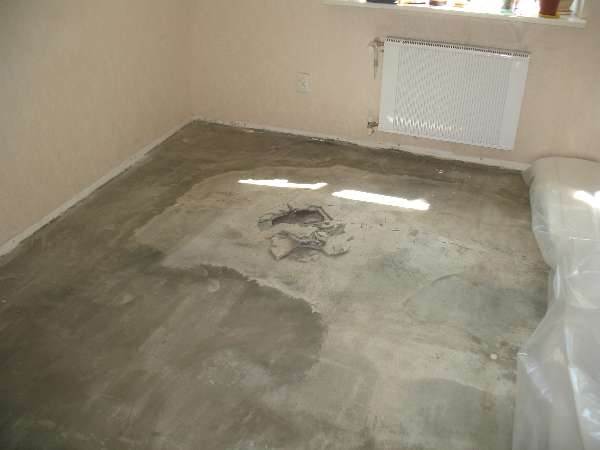
- Over the entire surface to be treated;

- All components or at home are mixed in any container;
- The solution is poured from the highest point of the entire site. She can be found laser level. The solution is rolled out with a special needle roller, which may have a limit bar to regulate the thickness of the self-leveling floor;

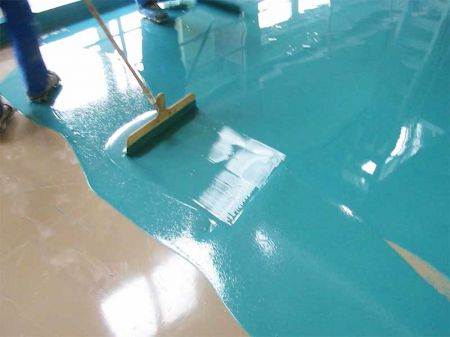
- If there is a need, then special decorative particles are applied to the newly poured composition;
- After 12 hours, the surface is varnished;
It must be said that the floor hardens within 24 hours, but it acquires full hardness only after 7-10 days. This applies to all types except methyl methacrylic - its hardening time is much shorter, only 2 hours, and full readiness occurs already on the second day.
Advice!
You should not use self-leveling floors as a leveling screed.
A mixture of this kind hardens on uneven surfaces in the form of shells or compactions, which will further aggravate the situation.
Really, general characteristics self-leveling floors do not allow them. Before using the self-leveling floor mixture, the subfloor should already be as level as possible. This can be done using dry mixtures, the price of which is significantly lower than the cost of the above materials.
Dry leveling mixtures
In the case where the floor has uneven surfaces and its area is relatively small, you can level the surface with your own hands using ordinary cement mortar.
However, if the room has a significant area, then it is better to level its floor using special mixtures. Such mixtures are Vetonit 3000 and Vetonit 5000
Vetonit 3,000
Apply by hand. It has cement base. Lays down in a layer of approximately 5 mm. This layer can withstand pressure from furniture, as well as the load from office chairs on wheels.
The mixture is prepared quite simply:
- Take a bag of dry mixture, that is, 25 kg;
- Mix with 6.5 liters clean water, as a last resort, it is allowed to add another 0.5 liters;
- Mix the mixture for one minute with a drill.
The prepared solution can be used within about half an hour after adding water.
Advice!
When installing the coating in a cold room, it is best to use slightly heated water (30-40 degrees).
This will allow you to easily stir the mixture without compaction.
Vetonit 5,000
Applied by hand. This mixture is capable of forming a layer with a thickness of 5 to 50 mm. As a filler it can have a layer of up to 8 cm.
Used in cases where it is necessary to make a floor that can withstand heavy loads.
The mixture is prepared as follows:
- A bag of dry mixture, that is, 25 kg;
- Take 3.5 liters of water; if necessary, you can add another 0.5 liters of water.
- The resulting mixture is kneaded for about 1 minute.
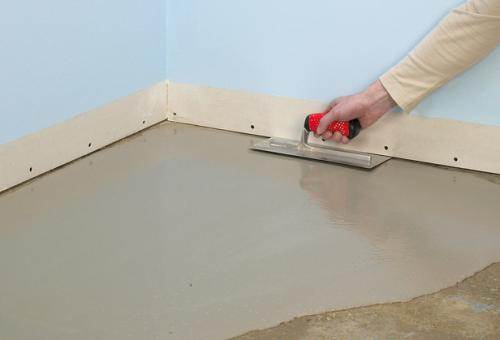
Conclusion
From all of the above we can conclude that self-leveling floors are great way transform your home. Due to its properties and diversity, this type of flooring has become widespread in the construction industry. The video in this article can tell you even more." width="640" height="480" frameborder="0" allowfullscreen="allowfullscreen">
Suitable for use within 30 minutes from the moment of adding water.
Conclusion
From all of the above, we can conclude that self-leveling floors are a great way to transform your home. Due to its properties and diversity, this type of flooring has become widespread in the construction industry. The video in this article can tell you even more information.
Self-leveling floor(polymer floor, liquid linoleum), are often used in the construction of modern premises. This material visually resembles household polyvinyl chloride linoleum, and to the touch it resembles a smooth tile, that is, it is a smooth, monolithic coating without any seams or gaps.
Depending on the materials used, self-leveling floors are classified into epoxy, cement-acrylic, methyl methacrylate and polyurethane. Typically, polyurethane flooring is used in residential areas. While the first three representatives are a great option For production premises.
The material is characterized by strength, wear resistance (resistance to abrasion, as well as abrasive action), durability (service life is 20 years or more), chemical resistance (floors are resistant to aggressive chemicals, acids, alkalis, solvents, salts, petroleum products), lightness , heat resistance (withstands temperatures ranging from -70 – +100 degrees) and, importantly, safety for human health.
In addition to the above advantages, polyurethane floors are fireproof, seamless, dust-free, decorative and aesthetic. Polyurethane was synthesized 75 years ago. Thanks to unique properties of this material The world's leading brands have long been using it as a basis for flooring.
Scope of application of self-leveling floor
Seamless self-leveling floors are usually used where special requirements are placed on the floor covering. Thanks to the use of this material, resistance to chemical reagents and high humidity is ensured. First of all, self-leveling floors are convenient for offices with high operational load, industrial premises, television studios, educational and medical institutions, etc. In residential premises, such covering is installed in bathrooms, kitchens, glazed loggias, and cottages. Recently, such floors have begun to be installed in garages and workshops.
Technology and device of self-leveling floor
Before installing the self-leveling floor covering, the “working” area is carefully prepared. To do this, you need to level the surface, remove all potholes and cracks, prime the base and waterproof it. A thoroughly primed base - stone, tile, concrete, metal, wood, etc., should not absorb liquid and be smooth glossy surface. Otherwise, bubbles will form on the new coating, which are difficult to remove.
After preparing the base, take two cans of different composition(the total weight of the cans is about 40 kg). Chemical composition, the components included in this mixture are known only to the manufacturer. The chemical composition of the mixture and the ratio of components in it are a production secret.
Be that as it may, the chemical composition of this product may be different, but the technology of floor installation and coating for all types of polymer floors is the same. So, the entire contents of the small container are poured into a large jar, after which the liquid is thoroughly mixed using an electric drill with a special attachment. In just a few minutes the working mixture is ready for application to the surface.
Using special equipment (usually a needle roller), the polyurethane mixture is gradually poured onto the coating and evenly distributed over the entire surface. Using a needle roller, air bubbles that appear on the liquid floor surface are removed. Many experts argue that the thickness of the flooring in residential premises should be one and a half millimeters, although in some cases it reaches 7 mm. The fact is that making a floor in a living space thicker than 1.5 mm is uneconomical, since it will require significantly large quantity material, and thinner is impractical.
Without special skills and appropriate practice, you should not buy or install these floors with your own hands, since, like any other business, there are nuances and pitfalls here. For example, during work it is necessary to observe temperature regime(from +5 to +25°C), be sure to monitor the air humidity (about 60%). At high humidity, the self-leveling floor takes longer to “set.”
Self-leveling floors, until dry, are afraid of moisture, its structural components easily react with water, so the floor surface must be dry, its humidity should not exceed five percent. To measure humidity, experts use a special device - a hygrometer. If the surface is prepared according to all the rules, then approximately 24 hours after the coating has dried, no moisture is scary for this floor.
Many people believe that self-leveling floors have a small selection of colors. But today you can already find more than twelve different colors on sale, of the entire range the most popular are neutral tones - beige, light green, brown and gray. Manufacturers of self-leveling floors have come up with an interesting decorative effect - multi-colored acrylic particles are applied to a fresh coating different sizes and shapes. This decorative touch gives the flooring depth and visual impact. natural material, for example, granite, marble.
Advantages and disadvantages of self-leveling floors
The main advantages of this coating are considered to be aesthetic appearance, shine, moisture resistance, solid color, wear resistance, durability, high resistance to temperature changes and the action of various chemicals (including aggressive ones), ease of cleaning, hygiene, fire safety, non-toxicity, absence of gaps and seams.
Self-leveling floors, compared to other types of coatings, are characterized by a poor variety (design); some types turn yellow or become discolored when exposed to ultraviolet radiation. The following disadvantages of such a coating are considered to be: labor-intensive preparation of the base for the coating, strict control of temperature and humidity in the room. The polymer coating is quite difficult to remove. The disadvantages include the fact that it is a synthetic material.
The main competitors of self-leveling floors are linoleum, tiles and laminate. When comparing these materials, it turns out that self-leveling floors will last much longer compared to linoleum, although they are significantly inferior in design. Compared with ceramic tiles self-leveling coating also has advantages because it does not have seams and has higher strength. Compared to laminate, this coating has higher moisture resistance.
Global branded companies producing self-leveling floors
On domestic market The main manufacturers of polymer floors are presented - Danish, Finnish, French, Swedish, German. Some experts believe that self-leveling floors are Russian manufacturers are in no way inferior to imported ones. All products must undergo certification before entering the market.
The price of the domestic kit is about 180 US dollars. One set is enough to cover a room up to 15 m2. Based on this, the price of the “filling” will be about $10. When “pouring” floors from imported manufacturers, its price can be 8-100 dollars. per m 2.
In workshops of enterprises, hangars, warehouses, garages, trading floors, floors are subject to blows, mechanical stress, increased pollution, temperature and humidity changes.
Consequently ordinary cement screeds and concrete quickly wear out, crack and become unusable.
Solving the problem can be filling the surface with plastic polymers, which are excellent resist deformation and wear, resistant to chemicals, aesthetic and hygienic.
Such properties allow use self-leveling polymer floors at any enterprises, offices, medical and chemical laboratories, pharmacies and even in exhibition halls and museums.
Types of polymer self-leveling floors
Exists several types with different qualities and applications. Mainly depends on properties the predominant polymer component from which the filling mixture is made. I would especially like to point out that certain species are also obtained by combining different materials.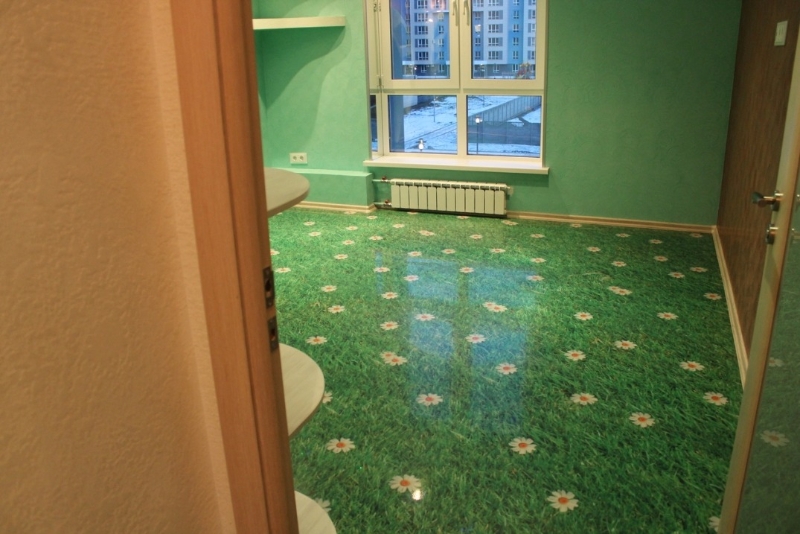
Plastic polyurethane resin after hardening has increased durability to loads and prevents the occurrence of cracks and defects in the floor covering. Therefore polyurethane should be filled in rooms with high friction and mechanical loads, such as the hallway of an apartment, a car showroom or a store. 
Epoxy self-leveling floors
Epoxy resin has all the properties of polyurethane, but at the same time it more resistant to moisture and chemical influences. Epoxy floors should be used in bathrooms and kitchens, as well as in laboratories and hospitals. 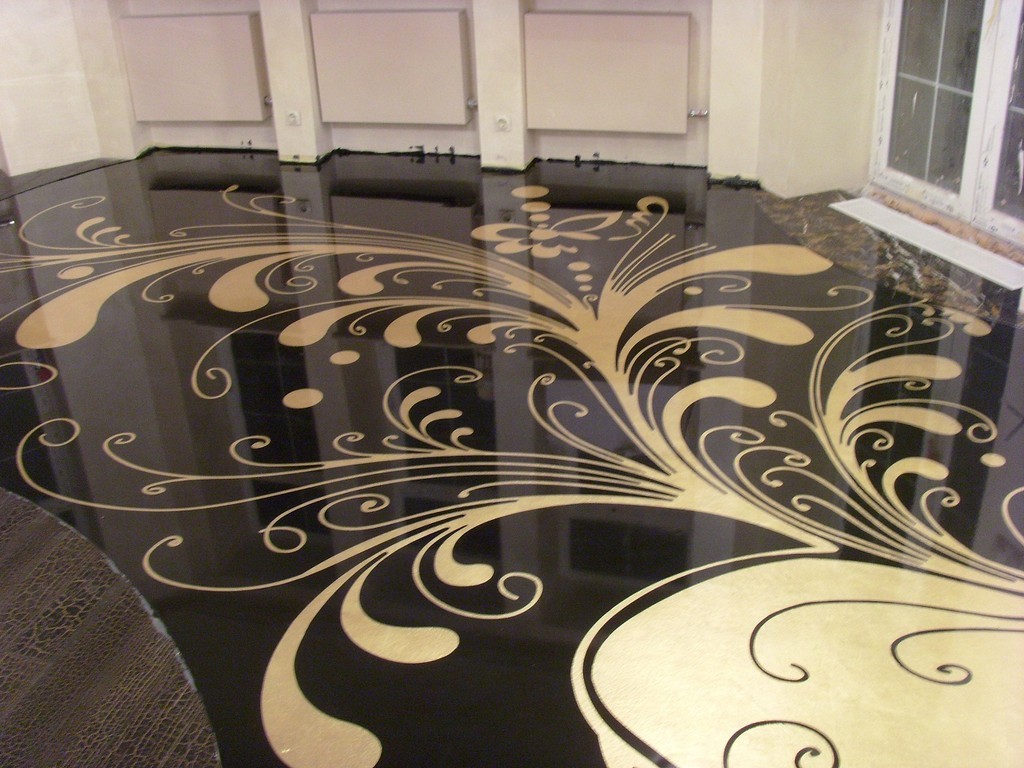
Methyl methacrylate floors considered universal, although less durable than the others. Their main advantage is resistance to low temperatures, due to which they are mostly used in large industrial premises, various garages and hangars. 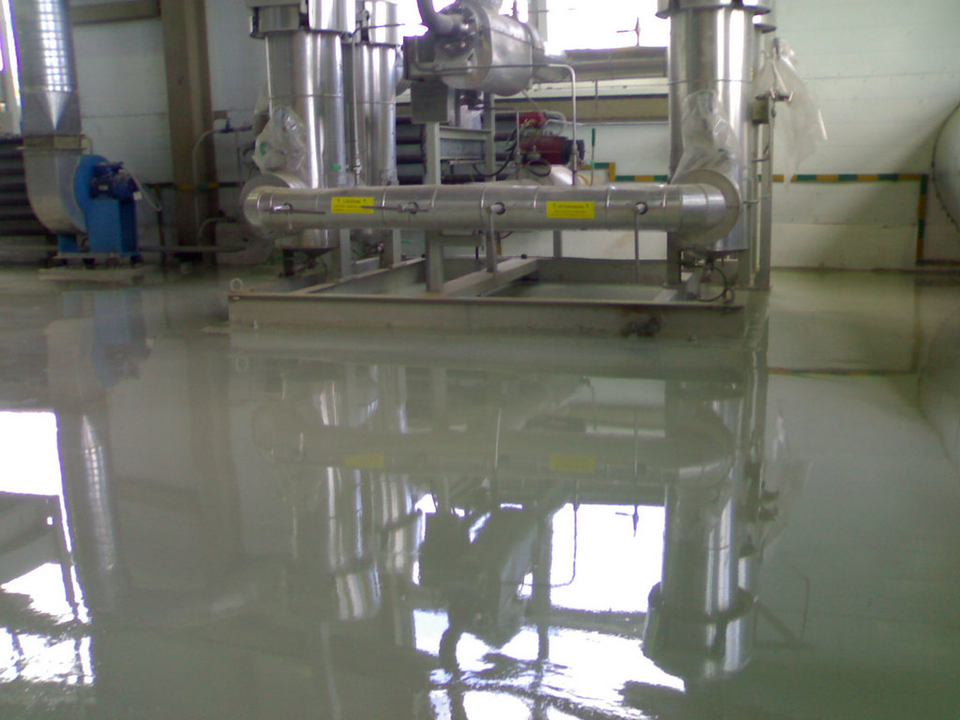
Cement-acrylic floors
This type is made based on methyl methacrylate when mixed with cement. This is done to increase the strength of the floor covering while maintaining the resistance to cold conditions inherent in methyl methacrylate floors. 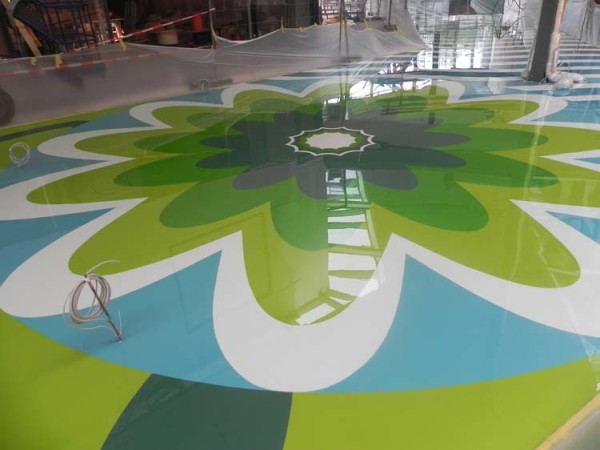
Epoxy urethane floors
The combination of these two basic polymers makes it possible to combine all the advantages epoxy resin and polyurethane. The result is separate species With special properties, allowing them to be used for both practical and aesthetic purposes. 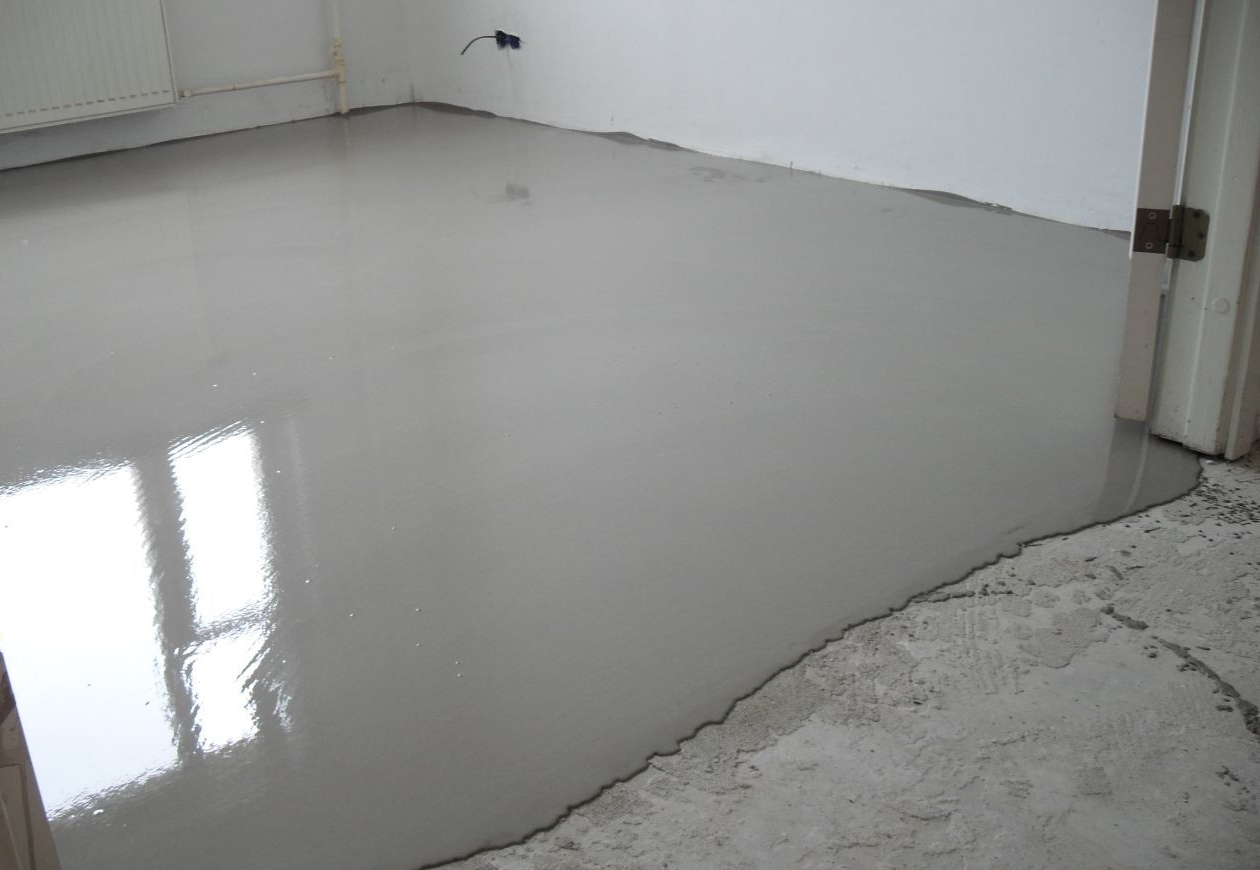
Characteristics of polymer self-leveling floors
The technical characteristics of each type are mainly determined by the properties of the polymer, however, they are also influenced by the type of base, the correctness of the work when pouring and the thickness of its layer. Subject to all technology conditions, polymer floors have the following characteristics:
Mechanical strength
After complete hardening, polymer screeds 6 mm thick withstand tensile load and deformation of 80 MPa, which approximately corresponds to a pressure of 800 kg per square centimeter. Such indicators make it possible in most cases to get by with thinner layers from 2 to 5 mm. Friction abrasion also does not exceed several microns in a year. 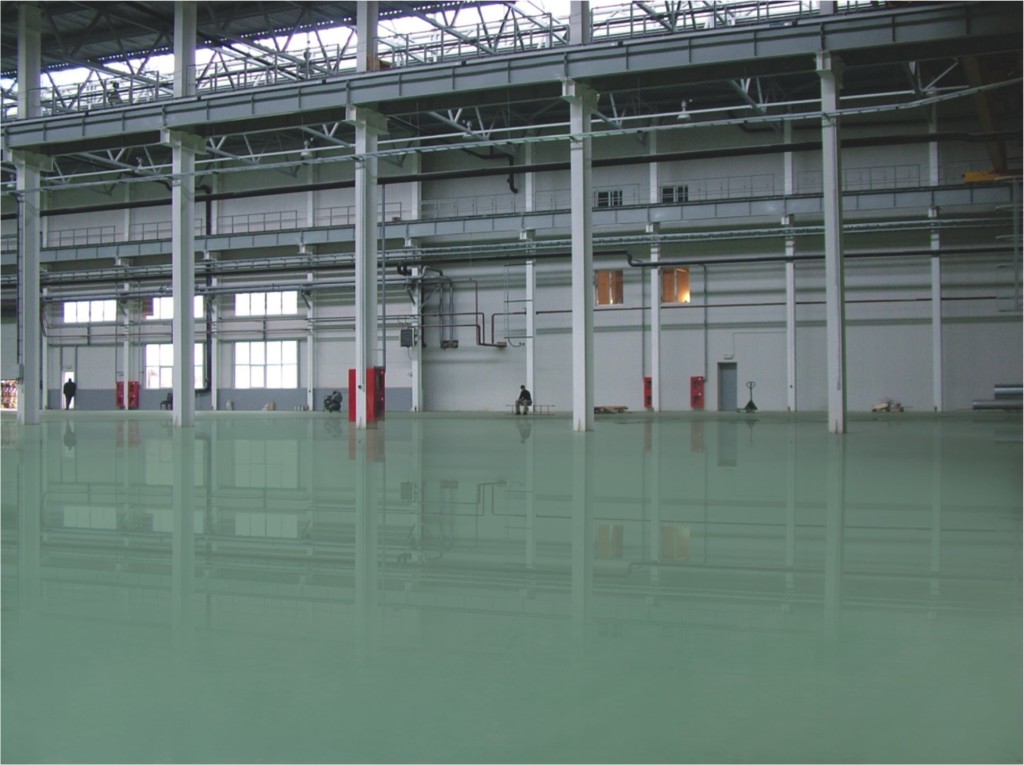
Temperature influence and fire resistance
Temperature difference environment, which does not affect the condition of polymer floors is from -25 to +80°С. Ignition occurs at 472 - 550 ° C, while the flame spreads slightly and smoke formation is moderate. 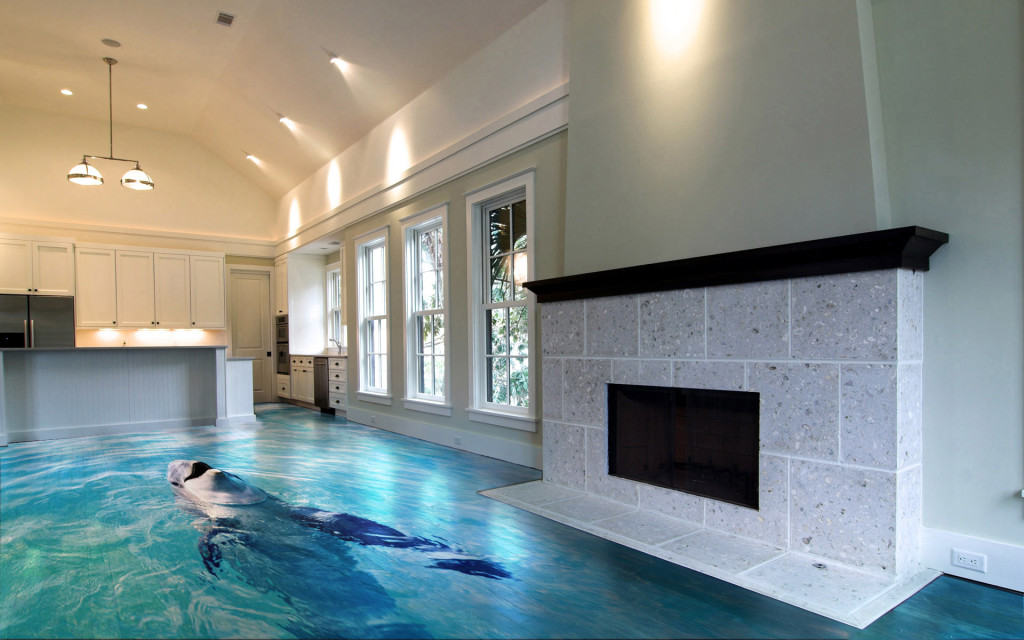
Chemical resistance
Resistant to most acids, alkalis, and other chemical solutions. At room temperature all types of polymer floors are not affected by them within a month. Exception is a slight dissolution of epoxy coatings during prolonged exposure to organic solvents (acetone, solvent, ethyl acetate). 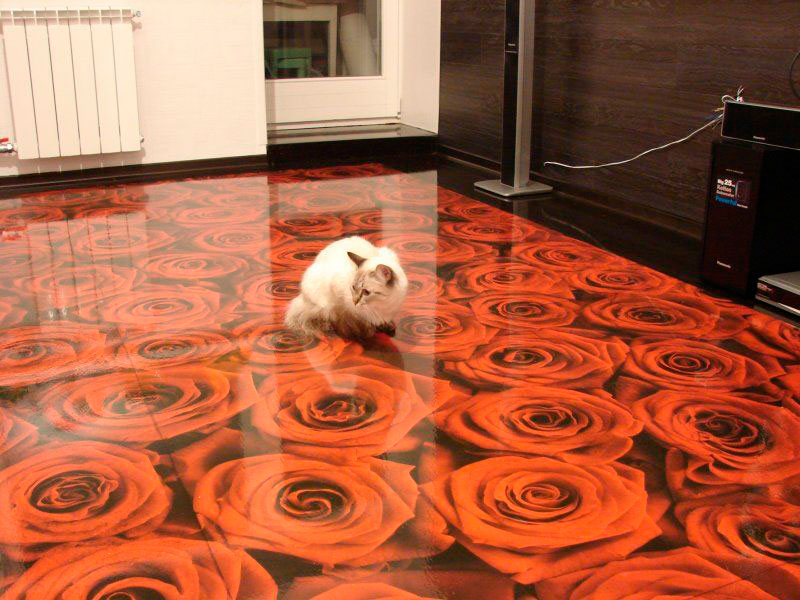
Environmental friendliness
All types of polymer floors absolutely safe and harmless for health and the environment, which is confirmed by relevant certificates.
Other characteristics
It is also worth noting the high electrical resistance, greater adhesion to all materials and no dust emission. 
Advantages and disadvantages
Due to these characteristics, polymer floors have a lot of advantages Compared to other types of flooring:
- Their service life can reach 40 years, wear is insignificant, and they are very easy to wash and clean.
- Another advantage - aesthetics. Modern technologies They allow you to make decorations in the form of any pattern, add any color, and even apply three-dimensional designs.
The disadvantages include:
- labor-intensive process dismantling for replacement or repair
- vapor tightness, which can lead to peeling of the polymer from the concrete base.

Installation stages
To fully appreciate all the benefits, during installation you need follow technology exactly. The work is carried out in several stages:
- Preparation of tools and materials.
- Preparing the rough surface.
- Filling the base layer.
- Applying the finishing coat.
Since the installation process it is not advisable to interrupt until complete completion, we recommend preparing everything necessary tools in advance. You will need several buckets for preparing the potting mixture, a drill with a mixing attachment, special spatulas, a squeegee with an adjustable gap, a needle roller to eliminate air bubbles on the surface ( For large areas one is not enough!) and solvents for cleaning instruments. Materials needed quartz sand to improve the bond between the polymer and the base, waterproofing material and the polymers themselves.
Important! We recommend purchasing extra bags of polymer mixture. If there is an error in the calculations and a shortage of material, the floor will have to be reinstalled.
Base surface needs to be cleaned and checked for absence of defects. Possible cracks, seams and irregularities should be prime, level with sealant and glue with fiberglass. The concrete can then be primed by applying a small layer of epoxy resin with a roller or trowel. To enhance adhesion, at this stage quartz sand is added to or on top of the primer.
Important! The primed base must dry for at least a day so that the moisture evaporates as much as possible.
Base layer evenly distributed over the entire surface of the base and leveled with a squeegee or wide spatula. When pouring, you should ensure that its thickness in areas of possible elevations of the base was not less than planned. We recommend starting pouring from the far corner towards the doorway, parallel to the walls. This way you can avoid disturbing the already filled space. On a carefully leveled surface you can spray a layer of quartz sand for greater durability. In this case, the hardened base layer will need to be sanded.
The polymer must harden from a day to three, depending on the thickness.
The final layer is applied thin, no more than 2 mm, layer after the base has completely hardened. Most often, this layer consists of a transparent compound mixed with a polymer. With its help properties polymer coatings reach maximum effect. The topcoat also serves as a protective coating for designs or patterns on the floor that may be printed on film or painted on. acrylic paints. It is at this stage three-dimensionality is also achieved images due to layer depth. 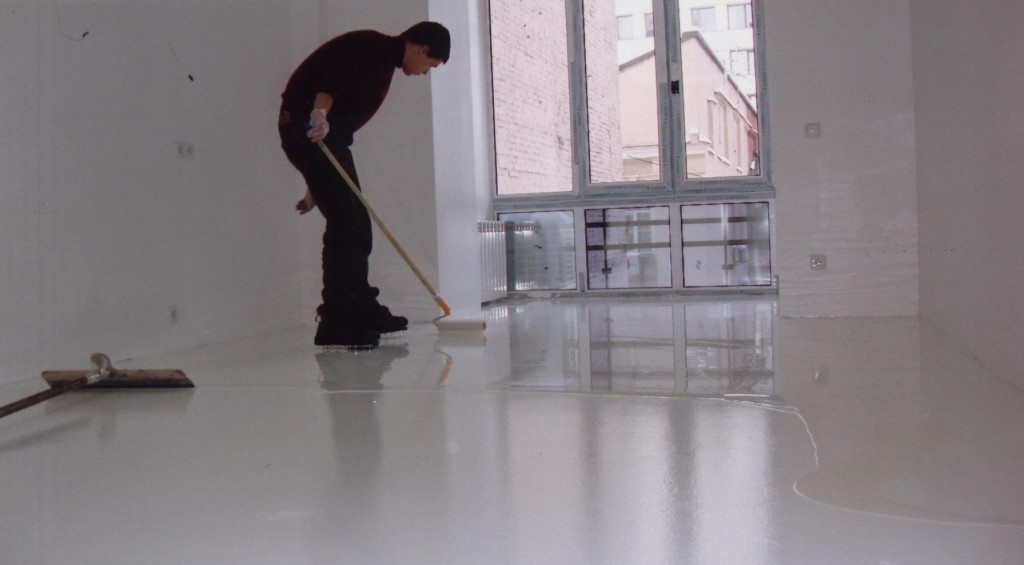
Labor and materials costs
Ease of installation and quality determine enough high prices for materials.
- The most expensive of all are methyl methacrylate, the price for which is on average 1200 rubles per square meter coatings.
- Other polymers can be ordered at an average price of 450 - 500 rubles per square meter, or 320 - 350 rubles per kilogram.
- The performance of self-leveling floor installation work by specialists is estimated from 380 - 420 rubles for thin layer painting with epoxy or polyurethane composition before 890 — 950 rubles for installation of a 2 mm floor of any color.
- The calculation is for each square meter. You will have to pay additionally 400 - 450 rubles per square meter of base, prepared according to all the rules.
- A square meter of decorative bases with a 3D pattern, depending on the complexity, will cost minimum 8000 rubles for materials and labor.




